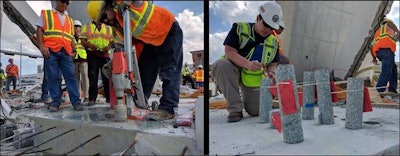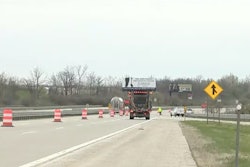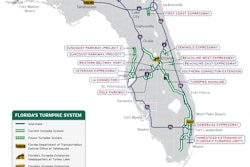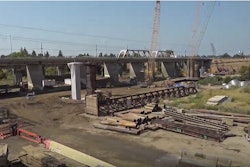 NTSB investigators at the FIU bridge collapse in March 2018
NTSB investigators at the FIU bridge collapse in March 2018Records released May 6 by the Florida Department of Transportation reveal that on the day of the collapse of a pedestrian bridge last year at Florida International University, the bridge designer reported that cracks observed in the bridge were not a safety concern.
The comments came during a meeting at 9 a.m. March 15, 2018—about five hours before the under-construction bridge collapsed in Miami, killing six people and injuring eight.
The meeting was attended by representatives of bridge designer FIGG Bridge Group, bridge construction contractor Munilla Construction Management, project inspection team members, the university and FDOT.
Since the bridge collapse, Munilla—now named Magnum Construction Management—has filed for bankruptcy. The construction firm has also reached a $42 million agreement with insurers to pay victims and their families, according to The Miami Herald.
The National Transportation Safety Board released a preliminary investigation report in November, saying “errors were made in the design of the 174-foot bridge, and cracking observed prior to the collapse is consistent with those errors.”
The “errors made were in the design of the northernmost nodal region of the span where two truss members were connected to the bridge deck,” an NTSB news release says. “The design errors resulted in an overestimation of the capacity (resistance) of a critical section through the node, and, an apparent underestimation of the demand (load) on that section.”
NTSB continues to investigate and has not reached a conclusion as to what caused the collapse.
‘No safety concern’
On March 13, 2018, two days before the collapse, FIGG conducted “about an hour of review and evaluation,” according to a Power Point presentation by FIGG at the March 15, 2018, meeting.
“FIGG had conducted sufficient supplemental/independent computations to conclude that there is not any concern with safety of the span suspended over the road,” FIGG’s presentation said. “Based on conservative calculations, it is concluded that the design meets LRFD (load resistance factor design) strength requirements for this temporary condition. … And therefore (there) is no safety concern relative to the observed cracks and minor spalls.”
According to meeting minutes, FIGG said the “cracks looked more significant in person than on photographs after site inspection performed prior to the presentation.”
On March 10, 2018, the bridge had been loaded onto permanent supports. On March 13, Munilla Construction Management emailed FIGG about cracks, and FIGG instructed Munilla “to install recommended temporary shims in the pylon base directly below member 12 between the permanent support shims,” the minutes say.
“FIGG assured there was no concern with safety of the span suspended over the road,” the minutes say.
During the meeting, a representative of the inspection team asked about the need for temporary shoring.
“FIGG responded that it was not necessary,” the minutes say.
“FIGG mentioned no repairs should be done now.” It said that once the back span is in place, “member 11 force will decrease.”
FIGG also said its analysis had predicted diagonal cracking.
A university representative, however, responded: “Nothing predicted this cracking.”
The inspection team member asked if there would be crack monitoring. The minutes noted that the inspection team “had been monitoring the cracks and insisted that (FIGG and Munilla) perform crack monitoring.”
There was no response from FIGG or Munilla.
The inspection team “confirmed cracks have increased in length daily,” the minutes say.
An FDOT representative then “asked if FIGG was going to continue to figure out why it happened?”
“FIGG responded that all we ‘know is that it just happened.’”
Munilla asked FIGG if there should be further inspection inside the cracks.
“FIGG said it didn’t want to core concrete out,” according to the minutes. “They want to move forward and seal cracks before being covered.”
“FIGG insisted that right now to not do any repairing of cracks until stabilizing the node and pylon diaphragm,” the minutes say. “The rest of corrective actions would be after construction of back span.”
The minutes also noted that a stressing operation was being performed on the bridge that day.
The inspection team representative asked for a copy of FIGG’s presentation and the results of the stressing procedure. The member asked whether the presentation had been peer-reviewed and said more people should be involved. The member “wanted more eyes on this and that the more eyes on this, the better,” the minutes say.
FDOT asked the inspection team its opinion of the FIGG presentation.
“At this point we cannot comment, will follow up on this request and expedite in 2-3 days,” is the response recorded in the minutes.
NTSB allowed records release
FDOT released the minutes of the meeting May 6 after receiving approval from the National Transportation Safety Board. The NTSB had blocked FDOT public-record releases pending its investigation, and FDOT was eventually able to get the block lifted.
“We support full transparency by providing all documents related to the March 2018 tragedy that impacted the South Florida community and our entire state,” said FDOT Secretary Kevin Thibault in a news release. “Lives were lost and other lives have been changed forever, and we know these families, as well as the citizens of Florida, deserve answers and want closure.”
FDOT, however, declined to comment about the released records.
“In the weeks to come, the many court cases and other various investigations will be ongoing, and we want to be respectful of those processes, and the families directly impacted by this tragedy,” Thibault said.
To see records released by the FDOT, click here.











